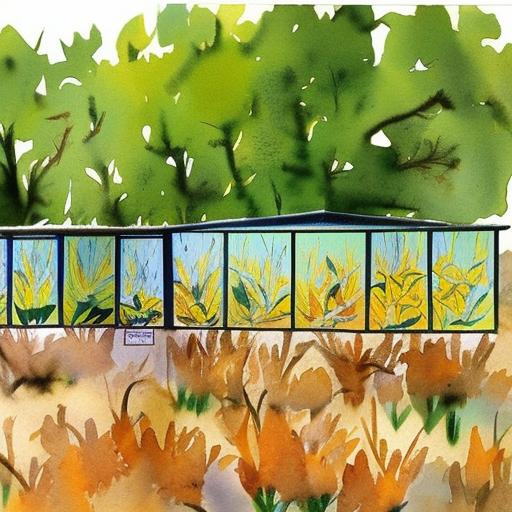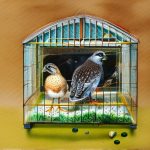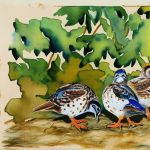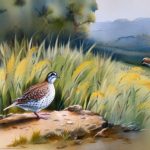When it comes to planning and designing your quail breeding pens, there are several factors to consider in order to create an ideal environment for your quail. First, you’ll need to decide on the size and layout of your pens. It’s important to provide enough space for your quail to move around comfortably, as overcrowding can lead to stress and aggression among the birds. Additionally, consider the number of quail you plan to breed and adjust the size of the pens accordingly.
Next, think about the materials you’ll use for the construction of the pens. Wood, wire mesh, and PVC are popular choices for building quail pens. Each material has its own advantages and disadvantages, so it’s important to weigh these factors when making your decision. Additionally, consider the placement of the pens within your property. You’ll want to choose a location that is well-drained, protected from predators, and provides easy access for maintenance and monitoring.
Overall, careful planning and thoughtful design are essential for creating a successful quail breeding operation. By taking the time to consider the size, layout, materials, and location of your pens, you can ensure a comfortable and productive environment for your quail.
Key Takeaways
- Plan and design your quail breeding pens with enough space for each bird and easy access for cleaning and maintenance.
- Choose materials for your quail breeding pens that are durable, easy to clean, and provide proper insulation and ventilation.
- Set up the ideal environment for your quail breeding pens by providing proper lighting, temperature control, and nesting areas.
- Maintain and clean your quail breeding pens regularly to prevent the spread of disease and ensure the health of your quail.
- Monitor the health and well-being of your quail in the breeding pens by observing their behavior, checking for signs of illness, and providing proper nutrition and hydration.
- Breed and incubate quail eggs in the breeding pens by providing the right conditions for egg laying, collecting and storing eggs, and using an appropriate incubator.
- Harvest and rear quail chicks from the breeding pens by providing proper nutrition, warmth, and protection from predators.
Choosing the Right Materials for Your Quail Breeding Pens
When it comes to choosing the right materials for your quail breeding pens, there are several options to consider. Wood is a popular choice for building quail pens due to its durability and natural aesthetic. Cedar and redwood are particularly resistant to rot and decay, making them ideal choices for outdoor pens. However, it’s important to avoid using treated lumber, as the chemicals used in the treatment process can be harmful to your quail.
Wire mesh is another common material used in quail pen construction. It provides excellent ventilation and visibility, while also keeping predators out. When selecting wire mesh, be sure to choose a gauge that is appropriate for quail. A 1/2-inch or 1/4-inch mesh is typically recommended to prevent quail from escaping or getting their heads stuck.
PVC is a lightweight and versatile material that is often used for constructing quail pens. It is easy to work with and resistant to corrosion, making it a low-maintenance option for pen construction. Additionally, PVC can be easily cleaned and disinfected, which is important for maintaining a healthy environment for your quail.
Ultimately, the right materials for your quail breeding pens will depend on your specific needs and preferences. By carefully considering the advantages and disadvantages of each material, you can make an informed decision that will contribute to the success of your quail breeding operation.
Setting Up the Ideal Environment for Your Quail Breeding Pens
Creating the ideal environment for your quail breeding pens is essential for the health and well-being of your birds. One of the most important factors to consider is temperature control. Quail are sensitive to extreme temperatures, so it’s important to provide adequate heating and cooling options within the pens. This can be achieved through the use of heat lamps, fans, or natural ventilation, depending on your climate and the time of year.
In addition to temperature control, it’s important to provide proper lighting within the pens. Quail require a consistent day-night cycle to maintain their reproductive health, so it’s important to ensure that they receive 14-16 hours of light each day. This can be achieved through natural sunlight or artificial lighting, depending on the layout and location of your pens.
Another crucial aspect of creating the ideal environment for your quail breeding pens is providing adequate nesting areas and bedding material. Quail require comfortable and secure nesting spaces in order to lay their eggs, so be sure to provide plenty of suitable nesting boxes or areas within the pens. Additionally, consider using soft bedding material such as straw or wood shavings to create a cozy environment for your quail.
Overall, creating the ideal environment for your quail breeding pens requires careful consideration of temperature control, lighting, nesting areas, and bedding material. By addressing these factors, you can ensure a comfortable and productive environment for your quail.
Maintaining and Cleaning Your Quail Breeding Pens
Maintaining and cleaning your quail breeding pens is essential for the health and well-being of your birds. Regular maintenance tasks include checking for any damage or wear and tear on the pens, repairing or replacing any broken or worn materials, and ensuring that all doors and latches are secure. Additionally, it’s important to regularly inspect the pens for signs of pests or predators, as well as any potential hazards that could pose a risk to your quail.
Cleaning your quail breeding pens is also an important part of maintaining a healthy environment for your birds. This includes removing soiled bedding material, droppings, and any leftover food or debris from the pens on a regular basis. Additionally, be sure to thoroughly clean and disinfect the pens between breeding cycles to prevent the spread of disease and parasites.
When cleaning your quail breeding pens, it’s important to use safe and effective cleaning products that won’t harm your birds. Avoid using harsh chemicals or toxic substances that could be harmful if ingested or inhaled by your quail. Instead, opt for natural or non-toxic cleaning solutions that are safe for use around animals.
Overall, maintaining and cleaning your quail breeding pens is essential for creating a healthy and comfortable environment for your birds. By staying on top of regular maintenance tasks and using safe cleaning practices, you can ensure the well-being of your quail and the success of your breeding operation.
Monitoring the Health and Well-being of Your Quail in the Breeding Pens
Monitoring the health and well-being of your quail in the breeding pens is crucial for identifying any potential issues early on and providing prompt care when needed. One of the most important aspects of monitoring your quail is observing their behavior on a daily basis. Pay attention to their activity level, eating habits, vocalizations, and interactions with other birds. Any changes in behavior could be an indication of an underlying health issue.
In addition to observing their behavior, it’s important to regularly check on the physical condition of your quail. This includes inspecting their feathers, skin, eyes, beak, and feet for any signs of injury, illness, or parasites. Additionally, be sure to monitor their weight and overall body condition to ensure that they are maintaining a healthy and stable condition.
Regular health checks by a veterinarian are also recommended to ensure that your quail are in good health. A veterinarian can provide valuable insights into the overall health of your birds and offer guidance on preventative care measures to keep them healthy.
Overall, monitoring the health and well-being of your quail in the breeding pens requires regular observation of their behavior and physical condition, as well as seeking professional veterinary care when needed. By staying vigilant and proactive in monitoring their health, you can ensure that any issues are addressed promptly and effectively.
Breeding and Incubating Quail Eggs in the Breeding Pens

Breeding and incubating quail eggs in the breeding pens is an exciting process that requires careful attention to detail in order to achieve successful hatching rates. When it comes to breeding quail, it’s important to provide a balanced ratio of males to females within the pens to ensure successful mating. A general rule of thumb is to have one male for every three to five females in order to prevent over-mating and aggression among the birds.
Once mating has occurred, it’s important to collect the eggs from the nesting areas within the pens on a regular basis. This helps prevent eggs from being damaged or contaminated by other birds within the pen. When collecting eggs for incubation, be sure to handle them gently and store them in a cool, dry place until they are ready to be placed in the incubator.
When it comes to incubating quail eggs, it’s important to maintain consistent temperature and humidity levels throughout the entire process. This can be achieved through the use of a quality egg incubator that is specifically designed for quail eggs. Be sure to carefully follow the manufacturer’s instructions for setting up and operating the incubator in order to achieve optimal hatching results.
Overall, breeding and incubating quail eggs in the breeding pens requires careful management of mating ratios, egg collection, and incubation practices. By following best practices for breeding and incubating quail eggs, you can increase your chances of achieving successful hatching rates and rearing healthy quail chicks.
Harvesting and Rearing Quail Chicks from the Breeding Pens
Harvesting and rearing quail chicks from the breeding pens is an exciting culmination of all your hard work in maintaining a successful breeding operation. Once the quail chicks have hatched from the incubated eggs, it’s important to carefully transfer them from the incubator to a brooder within a warm and secure environment. The brooder should be equipped with heat lamps or heating pads to maintain a consistent temperature for the chicks.
In addition to providing warmth, it’s important to offer proper nutrition for the growing quail chicks. This includes providing a high-quality starter feed that is specifically formulated for young game birds. Be sure to monitor their eating habits and adjust their feeding schedule as needed to ensure that they are receiving adequate nutrition for healthy growth.
As the quail chicks continue to grow, it’s important to gradually introduce them to their future living environment within the breeding pens. This can be achieved by allowing supervised access to an outdoor run area within a secure enclosure before fully integrating them into the main pen with adult birds.
Overall, harvesting and rearing quail chicks from the breeding pens requires careful attention to their environmental needs, nutrition, and gradual introduction into their future living space. By providing a warm and secure brooder environment, proper nutrition, and gradual integration into the main pen, you can ensure that your quail chicks grow into healthy adult birds ready for egg production or meat harvesting.
Overall, harvesting and rearing quail chicks from the breeding pens requires careful attention to their environmental needs, nutrition, and gradual introduction into their future living space. By providing a warm and secure brooder environment, proper nutrition, and gradual integration into the main pen, you can ensure that your quail chicks grow into healthy adult birds ready for egg production or meat harvesting. It is important to monitor their growth and development closely, making adjustments as needed to ensure they thrive. Additionally, providing a stress-free environment and minimizing any potential sources of harm will contribute to the overall well-being of the quail chicks as they mature. With proper care and attention, you can set the stage for a successful quail farming operation.
If you’re looking to build quail breeding pens, you may also be interested in learning about the importance of the floor in a chicken coop. A well-designed floor can contribute to the overall health and well-being of your poultry. Check out this informative article on PoultryWizard to discover the best flooring options for your chicken coop and how it can impact your birds’ comfort and hygiene.
FAQs
What are quail breeding pens?
Quail breeding pens are enclosures specifically designed for the purpose of breeding and raising quail. These pens provide a controlled environment for quail to mate, lay eggs, and raise their young.
What are the benefits of using quail breeding pens?
Quail breeding pens provide a safe and secure environment for quail to breed, which can increase the success rate of hatching and raising healthy chicks. They also allow for easier monitoring and management of the breeding process.
What materials are commonly used to build quail breeding pens?
Common materials used to build quail breeding pens include wood, wire mesh, PVC piping, and metal hardware such as hinges and latches. These materials are chosen for their durability, ease of cleaning, and ability to provide adequate ventilation and protection for the quail.
What are the key considerations when building quail breeding pens?
When building quail breeding pens, it is important to consider factors such as size, ventilation, security, and ease of access for cleaning and maintenance. The pens should also be designed to provide separate areas for nesting, feeding, and roosting.
Are there different designs for quail breeding pens?
Yes, there are various designs for quail breeding pens, including single-level pens, multi-level pens, and colony pens. The design chosen will depend on the specific needs and preferences of the quail breeder.
Are there any regulations or guidelines to consider when building quail breeding pens?
It is important to check local regulations and guidelines regarding the construction and use of quail breeding pens, as there may be specific requirements related to size, materials, and placement of the pens. Additionally, it is important to consider the welfare and well-being of the quail when designing and building the pens.
Meet Walter, the feathered-friend fanatic of Florida! Nestled in the sunshine state, Walter struts through life with his feathered companions, clucking his way to happiness. With a coop that’s fancier than a five-star hotel, he’s the Don Juan of the chicken world. When he’s not teaching his hens to do the cha-cha, you’ll find him in a heated debate with his prized rooster, Sir Clucks-a-Lot. Walter’s poultry passion is no yolk; he’s the sunny-side-up guy you never knew you needed in your flock of friends!







